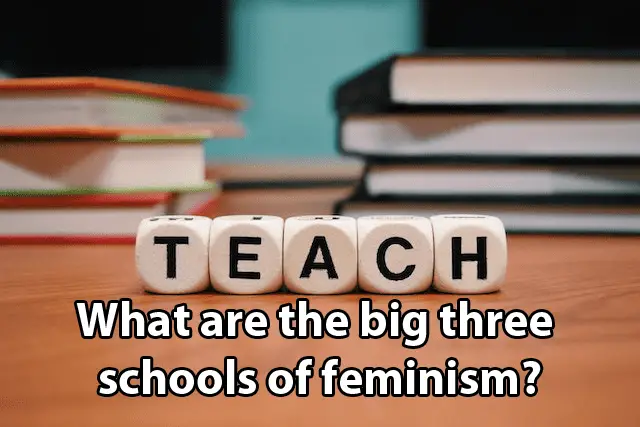
Prominent figures associated with the first school of feminism
Two prominent figures associated with the first school of feminism are Mary Wollstonecraft and Simone de Beauvoir. Wollstonecraft, an English writer and philosopher, is widely regarded as one of the founding voices of feminism. Her seminal work “A Vindication of the Rights of Woman” challenged the prevailing notions of women’s inferiority and argued for their equal rights in education and society. Wollstonecraft’s ideas laid the groundwork for advocating for women’s rights and their inclusion in public and intellectual spheres.
Simone de Beauvoir, a French philosopher and writer, further contributed to the first school of feminism with her groundbreaking work “The Second Sex.” Published in 1949, this influential text examined the historical and cultural construction of women as the “Other” and explored the implications of gender inequalities. De Beauvoir’s work profoundly influenced feminist thought, introducing concepts such as patriarchy, male privilege, and the social construction of gender. Her analysis was instrumental in shaping the feminist movement and challenging the prevailing gender norms of her time.
Influential texts and theories of the first school of feminism
The first school of feminism, also known as liberal feminism, emerged during the late 19th and early 20th centuries. One of the most influential texts of this school is “A Vindication of the Rights of Woman” by Mary Wollstonecraft, published in 1792. In this groundbreaking work, Wollstonecraft argues for women’s education and equal rights, challenging the prevailing notion that women were intellectually inferior to men. Her ideas laid the foundation for the advocacy of women’s suffrage and gender equality.
Another important text of the first school of feminism is “The Second Sex” by Simone de Beauvoir, first published in 1949. De Beauvoir’s work explores the concept of “the Other” and the ways in which women have been historically marginalized in society. She questions the social constructions that have defined women as objects and argues for women’s liberation from these imposed roles. “The Second Sex” remains a powerful critique of patriarchy and a call to action for feminists worldwide.
These influential texts of the first school of feminism have played a pivotal role in shaping the feminist movement and challenging societal norms. They have provided a foundation for feminist theories, inspiring subsequent generations of feminists to seek gender equality and dismantle oppressive structures. The theories put forth in these texts continue to be relevant and resonate with contemporary feminist movements, highlighting the lasting impact of the first school of feminism.
Key ideas and principles of the second school of feminism
The second school of feminism, also known as the liberal feminism, emerged in the late 19th and early 20th centuries. It can be characterized by its emphasis on equality and individual rights for women within the existing social and political systems. Liberal feminists argue that women should have equal access to education, employment opportunities, and political participation. They believe in dismantling the barriers that limit women’s opportunities and removing gender-based discrimination in all aspects of society.
One key idea of liberal feminism is the concept of gender equality. Liberal feminists argue that women are entitled to the same rights and privileges as men, and should be treated as equals in all spheres of life. They advocate for equal pay for equal work and the elimination of discriminatory practices that marginalize women in the workplace. Additionally, liberal feminists promote reproductive rights, including the right to access contraception and abortion, as well as the right to make autonomous decisions about one’s body. They believe that achieving gender equality requires the recognition and protection of women’s bodily autonomy and reproductive freedoms.
Prominent figures associated with the second school of feminism
In the realm of the second school of feminism, several prominent figures emerged, each leaving a lasting impact on the discourse of gender equality. One such figure is Simone de Beauvoir, whose groundbreaking work, “The Second Sex,” challenged societal norms and highlighted the oppressive nature of patriarchal systems. Through her exploration of existentialism and feminist theories, de Beauvoir paved the way for women’s liberation and empowerment, advocating for their autonomy and freedom from traditional gender roles. Her ideas sparked important discussions on the construction of gender and the need for comprehensive social change.
Another influential figure associated with the second school of feminism is Betty Friedan. As the author of the groundbreaking book, “The Feminine Mystique,” Friedan played a crucial role in reigniting the feminist movement in the 1960s. With her sharp critique of the constraints placed on women within the suburban housewife role, Friedan unveiled the hidden dissatisfaction and wasted potential experienced by countless women. Her work sparked a new wave of feminism, inspiring women to break free from the confines of domesticity and pursue their passions and ambitions outside the home. Friedan’s advocacy for women’s rights and her call for equal opportunities were instrumental in shaping the feminist movement and contributing to its remarkable progress.
Influential texts and theories of the second school of feminism
One of the most influential texts of the second school of feminism is “The Second Sex” by Simone de Beauvoir. Published in 1949, this groundbreaking work explores the concept of gender as a social construct and examines the oppression and marginalization of women throughout history. De Beauvoir argues that women have been defined and confined by their biological sex, perpetuating inequality in society. Her analysis challenges the traditional roles assigned to women and emphasizes the importance of women’s autonomy and liberation.
Another notable text is “The Feminine Mystique” by Betty Friedan, published in 1963. This book is considered a catalyst of the second wave of feminism in the United States. Friedan examines the lives of suburban housewives and identifies a pervasive sense of dissatisfaction and emptiness. She critiques the societal pressure for women to conform to traditional gender roles and advocates for women’s involvement in the workforce and pursuit of personal fulfillment. “The Feminine Mystique” ignited a national conversation about women’s rights and played a significant role in the women’s liberation movement of the 1960s and 1970s.
Key ideas and principles of the third school of feminism
Third wave feminism emerged in the 1990s as a response to the perceived limitations of the second wave. This school of feminism emphasizes intersectionality, acknowledging that gender is not the only source of oppression, and that it intersects with other forms of oppression, such as race, class, sexuality, and ability. Intersectional feminism seeks to address the experiences and needs of women from diverse backgrounds by emphasizing the importance of multiple identities and the complexity of lived experiences.
Another key idea of third wave feminism is the rejection of gender essentialism. Unlike earlier waves of feminism, which often focused on a universal experience of womanhood, the third wave recognizes and celebrates the diversity of women’s experiences and identities. This school of feminism recognizes that gender is not fixed or binary, but exists on a spectrum. It challenges the notion that there is a single, correct way to be a woman, and instead embraces the fluidity and individuality of gender identity. Third wave feminism also promotes body positivity and challenges traditional beauty standards, encouraging individuals to embrace and celebrate their own unique bodies.
Prominent figures associated with the third school of feminism
One prominent figure associated with the third school of feminism is bell hooks. Born Gloria Jean Watkins, bell hooks is an influential feminist author, activist, and educator. Her work challenges traditional notions of race, gender, and class, and she emphasizes the importance of intersectionality in addressing systemic oppression. In her book “Feminism is for Everybody: Passionate Politics,” hooks explores the need for a more inclusive feminism that addresses the experiences of women from diverse backgrounds. She argues for a feminism that is accessible and relevant to all individuals, regardless of their social location.
Another notable figure in the third school of feminism is Judith Butler. Butler is a philosopher and gender theorist whose work has greatly impacted feminist scholarship. In her book “Gender Trouble: Feminism and the Subversion of Identity,” Butler introduces the concept of gender performativity. She argues that gender is not fixed or innate, but rather a social construct that is continually performed and reinforced through individual and societal actions. Butler’s ideas have been widely discussed and have influenced various fields, including gender studies, sociology, and cultural studies. Her work challenges traditional binary understandings of gender and opens up new avenues for understanding identity and power dynamics.
Influential texts and theories of the third school of feminism
In the realm of feminist literature, the third school of feminism has produced a multitude of influential texts and theories. One prominent text is “The Second Sex” by Simone de Beauvoir, published in 1949. This groundbreaking work offers a thorough analysis of the oppression of women in patriarchal societies and explores the concept of women as “Other.” Beauvoir challenges the prevailing notion of femininity as a fixed and natural state, asserting that women are not born but rather made into their societal roles. Her provocative ideas continue to shape modern feminist discourse and provide a framework for understanding the complexities of gender inequality.
Another significant text in the third school of feminism is “Gender Trouble” by Judith Butler, published in 1990. This influential book challenges traditional notions of gender identity and argues that gender is not a fixed binary but rather a performative act. Butler contends that gender is constantly constructed and performed through language, gestures, and societal expectations. Her theory of gender performativity has had a profound impact on feminist and queer theory, inspiring further explorations of the fluidity and social construction of gender. By questioning the assumed stability of gender categories, Butler’s work has contributed to a more inclusive and nuanced understanding of identity within feminist scholarship.
Critiques and debates surrounding the big three schools of feminism
Critiques and debates surrounding the big three schools of feminism have been a topic of discussion among scholars and activists alike. One recurring critique is the lack of intersectionality in the first school of feminism. Critics argue that the focus on women’s rights as a singular group fails to take into account the experiences and struggles of women from different racial, ethnic, and socio-economic backgrounds. This critique highlights the importance of acknowledging and addressing the unique challenges faced by marginalized groups within the broader feminist movement.
Another ongoing debate surrounds the second school of feminism and its emphasis on gender as the primary axis of oppression. Some critics argue that this narrow focus neglects the complexities of power dynamics and fails to adequately address other interconnected systems of oppression, such as race, class, and sexuality. This critique underlines the need for a more inclusive and intersectional feminism that recognizes the multiple and intersecting identities of individuals, and the ways in which they shape their experiences of discrimination and privilege.
Impact and relevance of the big three schools of feminism in contemporary society
The impact and relevance of the big three schools of feminism in contemporary society cannot be overstated. These schools, namely the first, second, and third waves, have played a significant role in shaping the discourse and progress of gender equality. Their ideas, principles, and theories have inspired individuals, communities, and policymakers around the world to challenge patriarchal structures and advocate for the rights and empowerment of women.
Each school of feminism has brought forth unique perspectives and concerns. The first wave, emerging in the late 19th to early 20th centuries, focused on securing legal and political rights for women, such as the right to vote. Prominent figures associated with this wave, like Susan B. Anthony and Elizabeth Cady Stanton, laid the groundwork for subsequent feminist movements. Their influential texts, such as “The Declaration of Sentiments” and “The Feminine Mystique,” continue to serve as foundational texts for feminist scholarship and activism. The second wave, which gained momentum in the 1960s and 1970s, expanded the feminist agenda to address issues like reproductive rights, workplace discrimination, and sexual liberation. Figures like Simone de Beauvoir and Betty Friedan contributed seminal works, such as “The Second Sex” and “The Feminine Mystique,” respectively, which ignited discussions on the construction of gender and the intersecting oppressions faced by women. Finally, the third wave of feminism, emerging in the 1990s, sought to challenge the essentialism and exclusionary tendencies of previous waves. Figures like bell hooks and Judith Butler brought attention to issues like intersectionality and queer rights, promoting a more inclusive and diverse feminist movement. The theories and texts of the third wave, such as “Feminism Is for Everybody” and “Gender Trouble,” have opened up new avenues for critique and analysis, while emphasizing the importance of agency and individual experiences.












